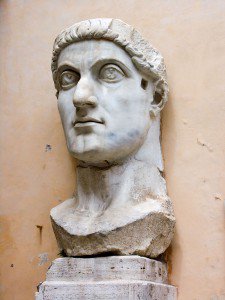Forces and motives that cause the rise and fall of empires
by Professor Alan Bowman FBA
15 Jun 2015
Analysis of the structural forces and the human motives that shape and change political, social and economic behavior over the longue durée is a large part of what history is about and the ‘lessons of the past’ should be applied sensitively and without dogmatism to the present and (within the limits of predictability) to the future. That is not to say that ‘history repeats itself’.

The legacy of the Roman empire in Europe, north Africa and the Middle East is profound and influential, not least in encouraging us to think about causes of the rise and fall of empires. This empire had strong political government and economic prosperity for several centuries. How should its ‘decline and fall’ be understood and does it matter to us, or to contemporary politicians? If the answer to second part of the question is negative, it becomes merely an antiquarian pastime with little current relevance or impact.
I believe it does matter. The recent general election turned out to be decisive, yet we may still wonder what might happen if no-one wins enough political support to establish a durable power-base. That is a critical matter, regardless of how the political support is expressed – through the democratic process, as in much of modern Europe, or through dictatorial control of military and economic resources as in ancient Rome (and not a few modern states too). In the Roman empire the power of the central government and the Emperor was by and large stable until the end of the Severan dynasty (AD 235). The following fifty years, sometimes called the ‘military anarchy’, saw a series of short-lived emperors (frequently more than one at a time) whose position was based on military support from regional sectors or sections of the army. Few lasted long and the tendency to form regional and ‘independent’ ‘sub-empires’ is notable (for example, in Gaul, Syria and Egypt, Britain).
The breakdown of control of communication routes was a critical factor in weakening a central government based in Rome and the fulcrum perceptibly shifted northward. As Sir Ronald Syme, one of the most distinguished 20th-century historians of ancient Rome, succinctly put it, ‘The key to the history of Europe is the line of the Orient Express’. After this period of ‘anarchy’ the emperor Diocletian was able to re-stabilise the empire at the end of the third century, by effectively restructuring the power of the emperor(s) in a collegiate form and by recognising the inevitable separation of west and east which was to lead to the foundation of Constantinople as an eastern capital and a massive increase in the complex bureaucratic structures of governance. The importance of the modern counterparts of such forces, not least in contemporary Europe, might be weighed against the emergence of more parochial, or even xenophobic, tendencies.
Ultimately, from the perspective of the reign of Constantine (AD 305 -337) one would not say that the whole empire had ‘collapsed’ or even declined in all regions. The east, and parts of north Africa, still look strong and vigorous, parts of the west less so as we move through the fourth and into the fifth century.
The economic picture broadly matches, with some severe monetary and fiscal dislocation in the period of ‘anarchy’, though the basic economic structures still functioned in some form, and recovery from AD 300 onwards. That recovery rested on reform and restabilisation of the currency, now based on gold in coined form (the ‘solidus’) – though we still do not quite know where or how fresh supplies of gold were acquired. It is also hugely significant that the state and the imperial house gradually withdrew from ownership and direct management of economic assets, principally by selling off their landholdings to private owners, whose tax position was relatively favorable. The rich became richer and the poor certainly did not – the gap seems to have widened and the socio-economic pressures were aggravated, particularly on the ‘middling’ urban residents who now seem to have a smaller share of the benefits of Roman rule. A resonant scenario?
Geographically, the overall picture is again patchy: significant prosperity and even demographic growth in the Middle East and north Africa, a more striking scenario of ‘decline’ in the north-west.
Then there is religion. In the second and third centuries the establishment was threatened by fanatical individuals and dissident groups, who challenged the law, the state religion, the social order, agitating the underprivileged, that is the poor and women (and even slaves), and seeking conspicuous and showy martyrdom for their beliefs without compromise. Does one forcibly suppress them or attempt to acculturate, to absorb them into the political and social structures? Who were they? The dangerous Christians, of course. Suppression was tried, and it failed. One individual (the emperor Constantine) was the catalyst of that failure and of the more inclusive approach which within a century led to the accumulation of massive wealth by the Church and to the conversion of individuals, families and social groups at the highest political and economic levels across the empire. But it was never exactly one homogeneous and harmonious community – there were (and still are) still huge sectarian and doctrinal differences within it, for which people were prepared to fight and to die.
Quo vadis? – as St Peter is supposed to have said.
Alan Bowman is the British Academy’s Vice-President for Humanities and Principal of Brasenose College, University of Oxford.
Photograph: “Rome-Capitole-StatueConstantin” by Jean-Christophe BENOIST. Licensed under CC BY 2.5via Wikimedia Commons.


